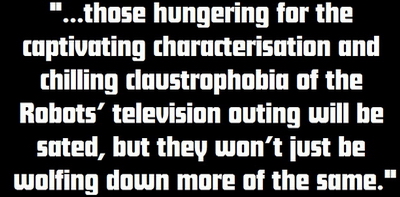|
| |
|
STORY PLACEMENT
THIS STORY TAKES "VALHALLA" AND "THE DOOMSDAY QUATRAIN."
PRODUCTION CODE 7Z/A/A
WRITTEN BY NICHOLAS BRIGGS
DIRECTED BY NICHOLAS BRIGGS
RECOMMENDED PURCHASE BIG FINISH CD#149 (ISBN 1-84435-577-8) RELEASED IN JULY 2011.
BLURB Nothing has ever been officially confirmed, but there is a rumour that on a Sandminer, bound for Kaldor City, the robots somehow turned homicidal and nearly wiped out the entire crew. Can that really be true?
The robot transport Lorelei has a cargo of MORE THAN 157,000 robots on board, all deactivated. So even if there were truth in the rumour of that massacre, there'd be no danger...
But then, the Doctor witnesses a murder. |
|
|
Robophobia JULY 2011 (4 EPISODES)
And so the drama continues. Thirty-four years after Chris Boucher’s anti-Asimov murder mystery The Robots of Death cemented itself as being one of Doctor Who’s all-time greats, Nicholas Briggs re-examines its eponymous automatons in the first instalment of Big Finish’s latest lone seventh Doctor season, Robophobia.
Until relatively recently, sequels to the Philip Hinchcliffe / Robert Holmes-era classics were, quite understandably, few and far between; only in the last few years have Big Finish found the gumption to attempt sequels to the likes of The Ark in Space, The Brain of Morbius and The Seeds of Doom. And whilst Boucher’s Robots eventually went on to star in their highly-regarded spin-off series, Kaldor City, to date they have only made one further appearance in Doctor Who, in Boucher’s inevitably-disappointing 1999 novel Corpse Marker.
But having Briggs write and direct an audio sequel to The Robots of Death seems to have led to an infinitely more satisfying story than Robots’ original writer could produce in print. In his youth Briggs religiously listened to his off-air audio recording of Robots, soaking up not only its story but its sounds. As such, he’s ideally placed to capture “the smile” in the Robots’ synthetic voices; to eke every ounce of enigma out his stellar performers; and to push sound designer and composer Jamie Richardson towards a soundtrack that doesn’t reiterate, but still evokes, the same mood as Dudley Simpson’s original.
More importantly though, Briggs’ intimate knowledge of the 1977 serial has allowed him to lift from it the elements that made it so exceptional and replicate them, yet present them with enough of a twist to shift the whole onus of the narrative and make Robophobia stand out in its own right. This time around, we’re on a solar ship carrying a cargo of Robots instead of a Sandminder staffed by them, but again its crew is being murdered and the Doctor is poking his nose in. The novelty lies in the manner in which the Doctor conducts his investigations, and the shocking truths that they uncover.
Gifting Sylvester McCoy’s Doctor with this story was a real masterstroke. Instead of having a wandering Doctor blithely stumble into an intergalactic Agatha Christie, we are faced with a mysterious, manipulative figure who seems to know all the answers from the outset, but wants the Lorelei’s crew to work them out for themselves. This can be seen most clearly in his relationship with Liv Chenka, the ship’s unlucky-in-love Med Tech, who unwittingly finds herself doing much of the Time Lord’s job for him. Spooks star Nicola Walker is absolutely terrific in this makeshift companion role, endearing herself to the listener within the space of just a few short scenes, before going on to develop an affinity with McCoy’s Doctor that would have certainly warranted exploration over a few more stories.
are equally inspiring, but none more so than famed one man show Toby Hadoke, who play’s the ship’s fretful security chief, Farel. Those who’ve listened to Hadoke’s Captain Richter in Cyberman 2 will see shades of that daunting performance here, but this play also gives Hadoke opportunity to show off the softer side of his repertoire, particularly in the stirring final episode. Dalek operator and Spectre of Lanyon Moor scribe Nicholas Pegg is very nearly as brilliant as the ship’s almost comically-listless Captain, Selerat, while new series Sontaran Dan Starkey gives voice to a character who’s anything but uniform or militant.
Overall, I couldn’t possibly commend Robophobia enough. In
listening to it, those hungering for the captivating characterisation and
chilling claustrophobia of the Robots’ 1977 television
outing
will be sated, but they won’t just be wolfing down more of the same. If
anything, Briggs’ script is even more
gripping and suspenseful than the
television serial
that spawned it – it’s certainly more surprising.
|
|
|
Copyright © E.G. Wolverson 2011
E.G. Wolverson has asserted his right under the Copyright, Designs and Patents Act, 1988 to be identified as the author of this work. |
|
|
The production code allocated to this tale – 7Z/A/A – suggests that it (as well as the two stories that follow it: The Doomsday Quatrain and House of Blue Fire) take place in between the Big Finish audio dramas Valhalla and Frozen Time. We have placed it accordingly.
Whilst still reportedly in police box form, the TARDIS appears to be black in this story. According to Sylvester McCoy, the reason for this will become apparent “in the future”.
|
|
|
Unless otherwise stated, all images on this site are copyrighted to the BBC and are used solely for promotional purposes. ‘Doctor Who’ is copyright © by the BBC. No copyright infringement is intended. |
|

.jpg)

.jpg)
.jpg)
 The
rest of Robophobia’s cast
The
rest of Robophobia’s cast